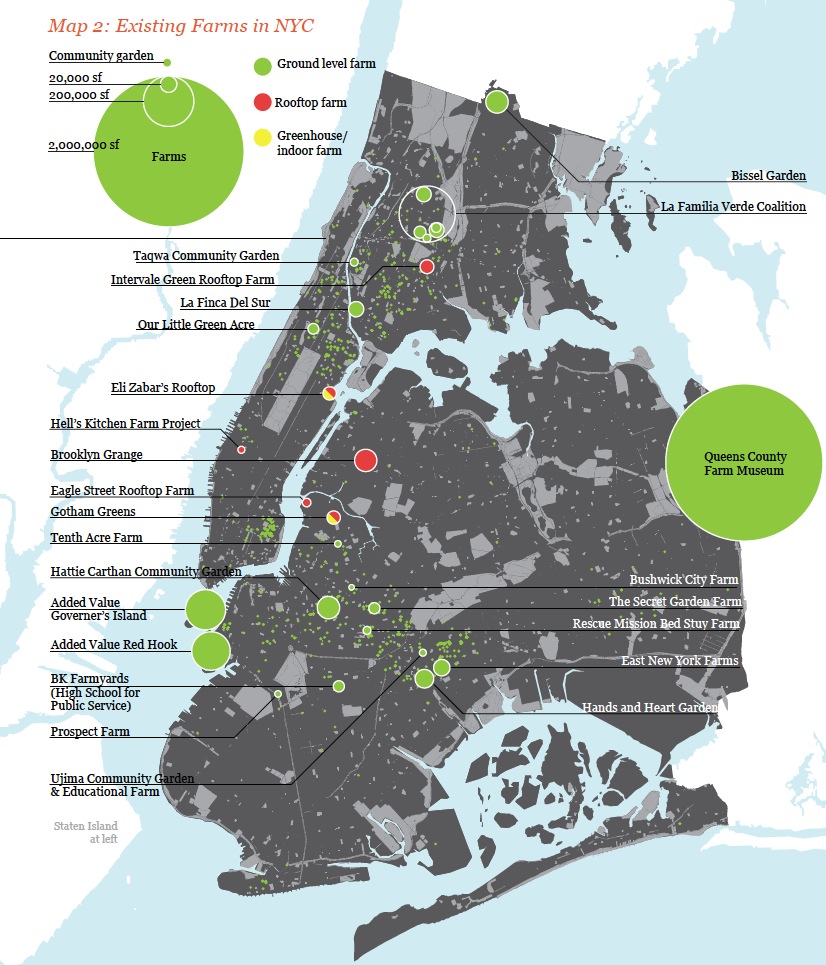THE URBAN DESIGN LAB
Executive Summary
With the generous support of the Doris Duke Charitable Foundation, the Urban Design Lab at the Earth Institute, Columbia University has conducted this comprehensive assessment of the potential for urban agriculture in New York City (NYC). This project is the first large-scale analysis of its kind for NYC, and while it is not definitive, we hope that the information and research will provide a baseline for understanding the critical issues related to urban agriculture in our city. The aim of this project is to outline and address a broad scope of issues that should be considered as public interest in urban agriculture continues to grow.
Study goals
There are two primary research questions that this study aims to address:
What is the capacity of NYC for urban crop production? Understanding how much land in NYC could be productively used for agriculture and horticulture, and how much could realistically be grown, are important steps toward increasing knowledge and establishing a baseline for evaluating the potential costs and benefits of urban agriculture. In this overview we considered which specific crops and products are most suitable for NYC’s urban environment, and evaluated site availability for land-based and rooftop agriculture.
What are the potential benefits of urban agriculture in NYC? Ensuring that productive urban green space remains a lasting and indelible part of the urban landscape will require clear, quantitative assessments of its costs and benefits. Issues considered as part of this project include: 1) impacts of urban agriculture on food security, including an assessment of the relationship between potential urban agriculture sites and the existing “food environment,” with the goal of diminishing disparities in access and improving public health; 2) Implications of agricultural land uses for stormwater runoff and combined sewer overflow (CSO) mitigation, focusing on the city’s most polluted waterways; 3) impacts on energy use, including consideration of how urban agriculture could mitigate the urban heat island effect and reduce built environment energy consumption; and 4) implications for waste reduction, which include evaluations of the city’s existing municipal and commercial waste streams and opportunities for composting for agricultural purposes.
Key findings in brief
- Urban agriculture can play a critical role as productive green urban infrastructure. There is significant potential for urban agriculture to provide critical environmental services to the city through stormwater runoff mitigation, soil remediation, and energy use reduction. At a time when municipalities are straining to address complex infrastructural challenges with limited budgets, productive urban green spaces will be increasingly important in their capacity to function as a cost-effective form of small scale, distributed green infrastructure.
- Urban agriculture can play an important role in community development. The benefits of urban agriculture are not limited to the provision of food, with many advocates citing community empowerment, environmental justice, public health, and education and training as primary goals. Urban agriculture can be a means of transforming underutilized or neglected space into a public resource, providing opportunities for social interaction, greater community cohesion and self-sufficiency, and engagement for young people in underserved neighborhoods.
- There is a substantial amount of land potentially available for urban agriculture in NYC. We have identified almost 5,000 acres of vacant land likely to be suitable for farming in the five boroughs, the equivalent of six times the area of Central Park. In addition to this land, there are many other potential sites, including over 1,000 acres of NYCHA green space, underutilized open spaces, and Greenstreets. There are also many other potentially suitable sites and properties that are not included in these designations that would greatly expand the total amount of land available for agricultural production. Each of these different types of sites would demand different approaches and strategies if they are to be deployed for agriculture. In this regard, existing data on land availability and suitability is inadequate to understand true capacity, and information on public (municipal) land is insufficiently accessible.
- Intensive growing methods adapted to urban spaces can result in yields per acre which greatly exceed those of conventional production techniques. More land under fruit and vegetable cultivation will be needed if the population is to shift to a healthier diet. Employing high-yield or “biointensive” production techniques characteristic of urban agriculture can contribute to this goal. Widely-practiced intensive farming techniques for small sites in urban areas, such as intercropping, intensive soil management, or hydroponic cultivation can convert underused or neglected urban space into a highly productive community asset.
About the Urban Design Lab
www.urbandesignlab.columbia.edu
“The Urban Design Lab is a joint laboratory of the Earth Institute and the Graduate School of Architecture, Planning and Preservation (GSAPP). It was created in 2005 to address the need for a design-based approach to shaping the long-range future of sustainable urbanism. New York City and its regional context is viewed as a core model for solving problems related to sustainable urban futures everywhere, including Latin America, Asia, Africa, and Europe.”
Tags: Columbia Unviersity, Green Infrastructure, Manhattan, New York, New York City, The Urban Design Lab, Urban Agriculture







 RSS Feed
RSS Feed